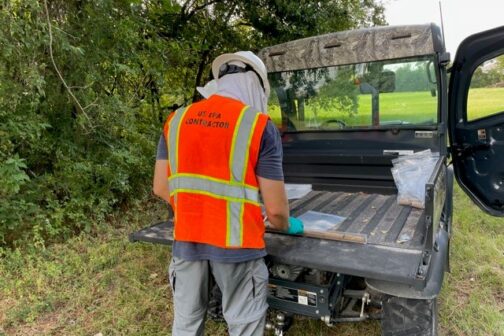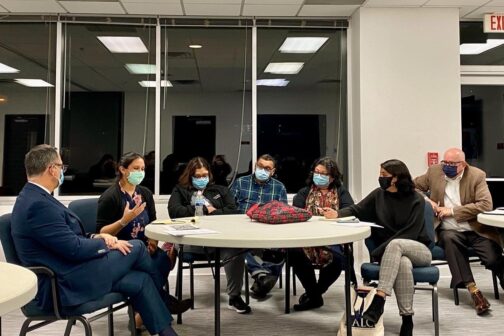Soil testing conducted by Environmental Protection Agency has found asbestos contamination in West Dallas properties adjacent to the former W.R. Grace vermiculite processing plant, which has since been demolished and is now the location of a concrete batch plant.
W.R. Grace operated the Texas Vermiculite Company on Manila Road from 1953 to 1992, processing the mineral so it could be used by a variety of uses—everything from shingle and insulation production to gardening. The plant shut down nearly 30 years ago.
Not all vermiculite contains asbestos, but 396,910 tons of the raw vermiculite ore processed between 1967 and 1992 at the West Dallas plant came from a mine in Libby, Montana. That mine was shut down in 1990 after 70 years of strip-mining exposed workers, their families, and the residents of Libby to a toxic form of asbestos in what the EPA would later call one of the worst cases of industrial poisoning of a whole community. W.R. Grace also owned the mine.
The fallout from the contamination included criminal charges against three company executives that alleged the company knew of the contamination and conspired to cover it up. Those executives were acquitted, but the company filed for Chapter 11 bankruptcy in 2001 in part to resolve the thousands of asbestos-related claims that stemmed not only from the Libby site, but the plants that received vermiculite from Libby.
During the processing of the ore at the West Dallas site (and, for that matter, other processing plants across the country), the EPA and the Centers for Disease Control and Prevention’s Agency for Toxic Substances and Disease Registry believes that the plant site (and now also the neighborhood around it) may have been contaminated by the asbestos and asbestos-like threads that were released into the environment during processing.
W.R. Grace removed its processing equipment from the location in 1997. Prior the facility’s demolition in 2001, an EPA visit noted a potential pile of vermiculite near the railroad tracks near the plant, and a fine layer of the mineral “might cover the entire site.” The reported noted that the site was not only unsecured, but also that “children were observed playing in the operations/process building.”
As part of the cleanup in 2001, W.R. Grace excavated and removed the foundations and one foot of surface soil, and backfilled that area with clean soil before grading and seeding the area, an EPA assessment details.
The company faced more than 129,000 asbestos claims in 2001. Its reorganization through bankruptcy included the provision for an asbestos personal injury trust and a similar trust for property damage claims. It paid for those trusts with more than $4 billion, and made its final $490 million payment in 2015, about a year after it emerged from bankruptcy. The settlement also required the company to pay more than $63 million to resolve claims at another 32 EPA-defined Superfund sites where it also operated.
W.R. Grace was acquired in 2021 by Standard Industries, which is also the parent company of the nearby GAF shingle factory. Standard is now in talks with the city and community organizations Singleton United/Unidos and West Dallas 1 to start winding up its operations after the communities around it insisted that it no longer fit the neighborhood and was endangering their health.
The remediation at the plant site didn’t end the issue, Singleton United/Unidos spokesperson Janie Cisneros said.
“When they shut the company down, they remediated the land where the facility was, but they never bothered to check the community,” she said. “They never bothered to check the soil beyond where the facility was, into the little neighborhood streets that we have over here.”
More recently, the EPA and the company have been working to obtain permission to test the soil from businesses and homeowners who were once neighbors to the facility, especially along Commerce Street from Manila Road to the end of Kingbridge Street. That is right behind the former Thomas Edison Middle School, which has been serving as the temporary quarters for Thomas Jefferson High School since an EF3 tornado severely damaged the school in 2019. D has reached out to Dallas ISD to find out whether the district was informed of its sample results yet.
“Luckily, we were able to get a lot of people on board and people to sign on and say, ‘OK, guess I’ll allow for the soil sampling in my yard,’ and the businesses, as well,” Cisneros said. “I did get a heads-up from the EPA that unfortunately, that several properties already from samples that they had done, had contamination of asbestos. Once all of the sampling gets done then we’re going to see how big the contamination is and there’s going to be a scheduling of remediation of the land.”

Neighbors have known the impact the plant had on their health for at least 15 years. In 2007, KERA reporter Bill Zeeble reported on a town hall where residents learned the results of special health screenings designed to check for asbestosis, or lung scarring, in 400 residents. With only half the results in at that time, 15 were found to have asbestosis, with another 15 showed possible signs of cancer. A doctor in the report said so many asbestos-related cases in one place was not normal.
Cisneros grew up on Bedford Street, where her father worked for W.R. Grace for more than a decade.
“I remember how his uniform would be dusted with flakes and powder when he would come home from work,” she said in a community testimony on the Singleton United/Unidos website.
Cisneros’ father continued to work for W.R. Grace for several years after the plant shut down, maintaining the grounds and mowing the lawn. His family, she said, often accompanied him to help him.
“I know our environment played a role in my dad’s declining health. He died young, especially compared to the age his parents passed. I wonder how he, along with other neighbors on Bedford Street who have passed due to illnesses like cancer and heart problems, could have lived longer had industrial polluters not been part of our home environment.”
West Dallas 1 president Raul Reyes said the community became aware of the assessment in November and facilitated a community meeting with the EPA, neighbors, the city’s Office of Environmental Quality and Sustainability, and Dallas ISD leadership.

“These are the environmental justice issues that West Dallas 1 has been bringing to the forefront for the past decade,” Reyes said, adding that the community is frustrated with the fact that it took two decades for the EPA to come back and check the neighborhood for contamination.
“While our neighbors are understandably interested in the new relationship between GAF Materials and WR Grace, we are curious to understand why the site sat on the EPA’s National Priorities List for as long as it did before an assessment, given the remediation needed at the other vermiculite processing sites formerly operated by W.R. Grace across the U.S.,” he said. “We need every level of government and policy maker working collaboratively to undo the legacy of environmental racism perpetrated against our community. West Dallas residents deserve to be on everyone’s priority list. We deserve a clean and healthy environment.”
So far, about 70 percent of the samples from the EPA survey are complete, said someone familiar with the operation who spoke anonymously. Once the survey is completed, WR Grace will create a map that will show approximate locations for all the hotspots.
Of those completed samples, seven sites were found to have asbestos levels that exceed the EPA’s cleanup standard, said agency spokesman Joe Robledo.
“EPA is now working with W.R. Grace to put together a plan for the removal of contaminated soils from the seven properties,” he said. “The cleanup work will begin in early September and will involve the removal of the contaminated soil, disposal in an approved landfill, backfill each property with certified clean soil, and re-seed or sod the properties.”
In an explainer to the community, the EPA said businesses and homeowners will be contacted by the agency if the soil on their property tests positive for asbestos. If homeowners need to leave during the remediation process, the agency said that they will be temporarily relocated at no expense to the owner.
Get the D Brief Newsletter
Author





